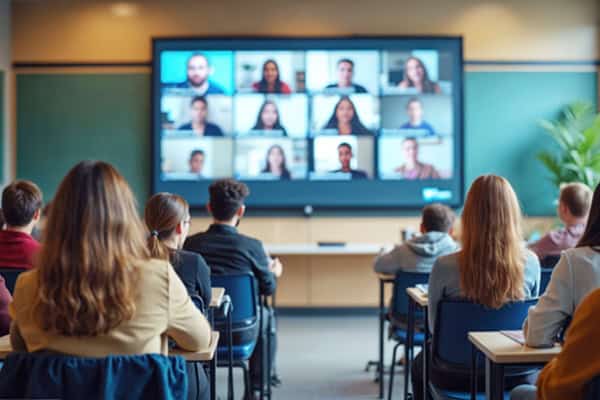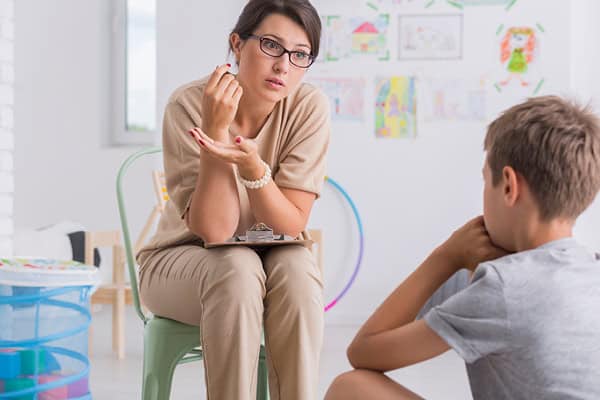Kansas City, Kansas, Public Schools (KCKPS) is in its third contract year with Proximity Learning, which markets real-time, virtual instruction from certified teachers who remotely wire into classrooms, according to an article in The Kansas City Star.
Virtual teaching is one of the options to ease the ongoing teacher shortage challenging schools nationwide. KCKPS district officials told The Star they see Proximity as a stopgap in efforts to build the local teacher workforce without sacrificing quality of learning.
But the strategy is going beyond a stop-gap band aid, expanding substantially. In the past three years, the number of KCKPS students in classes taught by virtual teachers has more than doubled — 1,813 in the 2022-23 school year to 3,848 in the 2024-25 school year. Virtual teachers taught 101 classes in KCKPS middle and high schools in their first year. The next year they taught 175 classes, and now in this school year they have taught 181 classes.
Critics of the distance learning program are concerned about student engagement in a virtual environment. Edwin Birch, lead spokesperson for KCKPS, said that misinformation during Proximity’s introduction to the district caused concern among parents, who thought children were being left unsupervised in classrooms. Now that parents know their children have certified teachers who are supervising the physical classroom every day, the district rarely hears concerns from community members.
Academic performance shows little variance between virtual and in-person teaching. District data indicates that similar numbers of students got As, Bs and Fs in classes taught by in-person teachers as they did in classes taught by virtual teachers.
Teachers on screens leading virtual classes must be certified to teach in the state of Kansas. They deliver live, online lectures to classes of in-person students, and students can ask questions to teachers by most commonly typing into a messaging program. A second instructor, typically an educational aide or someone working to acquire their certification, oversees the physical classroom and tries to assist the primary, virtual teacher on a day-to-day basis. When a virtual teacher misses five or more consecutive classes, the district has another virtual teacher move in to teach the class.
KCKPS exclusively uses Proximity Learning to fill teaching vacancies in core subject classes – math, science, social studies, English language arts – for grades 6-12. Most often these instructors are filling in for math or science classes. They appear on screens in classrooms of six middle schools and five high schools. Of the 3,848 district students that had a Proximity class during the 2024-25 school year, 46% had Proximity teachers in science and 26% had a Proximity teacher for math, according to the district.
Nine in-person teachers that the district hired going into the spring semester were district fellows who served as in-class aides to Proximity classrooms during the fall semester, according to KCKPS.
How do students and parents feel about virtual learning? One student, Khadka, said not having an in-person teacher means no more getting randomly picked to answer a question in class, and no more humiliation when you answer incorrectly. Khadka said that his parents had no idea he was in a Proximity Learning classroom this semester. He said KCKPS didn’t notify them, and he didn’t want to answer his parents questions. He doesn’t want his parents to think it’s his fault he doesn’t have an in-person teacher. The soon-to-be graduate wants to attend Kansas City, Kansas, Community College after high school. He hopes to study nursing.
Erica, a KCKPS parent with an eighth grader in the district, told The Star that she plans to enroll her son out of the county starting next school year. COVID learning wore on Erica’s son, and she’s concerned that missing out on the consistency of an in-person teacher may affect how he performs in high school. “I’m afraid that he’s not getting what he should’ve gotten, so we plan on leaving the district and going to a school that basically has full-time teachers,” she said. “I feel like once we started that virtual thing with COVID, it’s like, they did not stop that.”
And how do local teachers feel? Taylore Dionne Hood said she resigned from her English teaching job at Gloria Willis Middle School in 2024 for many reasons — a big one was feeling like she wasn’t being valued for her work. During her time at KCKPS, Hood said she would occasionally substitute for the in-person instructors serving Proximity Learning classes. “It’s usually just chaos, really, because I feel like people online, they can’t establish the control that you need and the interpersonal relationships you need.” She added that it’s particularly important for younger adolescents to establish stronger rules and structures in the classroom. She thought the Proximity teachers were, for the most part, qualified teachers, “but kids need connection at that age.”
The Kansas City Star




